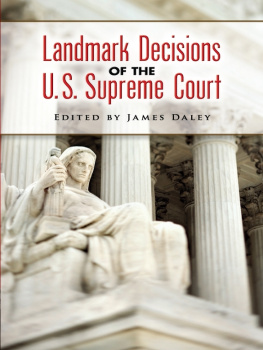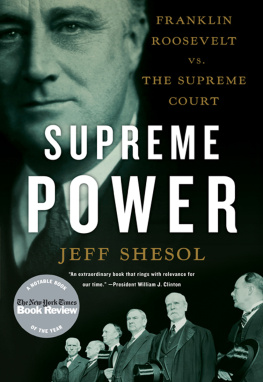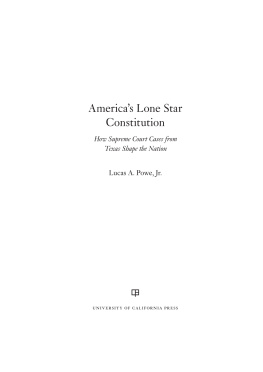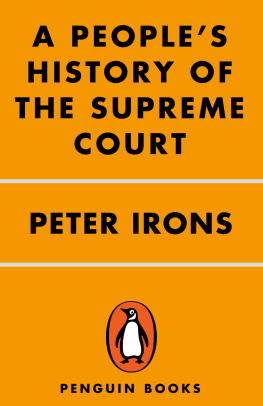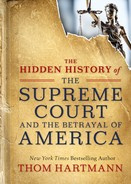PREFACE
The power and importance of the U.S. Supreme Court have never been clearer than in the early years of the twenty-first century. Since 2000, the court has decided the winner of a presidential election, declared an individual right to bear arms, rescued the biggest piece of domestic legislation in decades (also known as Obamacare), and cleared the path for same-sex couples to marry.
In most of those decisions, one side or the other argued that the Supreme Court was overstepping its authoritystealing power from other institutions or forces of our democracy. But the Supreme Court is a self-confident branch of government, not shy about taking on the most difficult issues facing the nation.
That bravado has become more obvious in part because of the dysfunctional relationship between the other branches. Congress and the president are constantly at odds with each other, and their ability to address tough issues is at an all-time low.
So it was perhaps inevitable that the Supreme Court would step into the breach. When the nation was thrown into weeks of uncertainty following the close vote of the 2000 presidential election, the court became the adult in the room and decided to end the recounts, handing the presidency to George W. Bush. Get over it was Justice Antonin Scalias response whenever he was asked about it. To many the decision in Bush v. Gore seemed more political than legal. But it was also final, and the country moved on. As Justice Stephen Breyer has noted, it was a crisis that in other nations could have put military tanks in the streets to restore order. But in the United States the public peacefully accepted what the court had done.
Similarly, some felt it was not the Supreme Courts business to ratify the concept of same-sex marriage. The democratic process should work its will state by state, these voices urged, to allow same-sex marriage to grow more organically. But a majority of the Supreme Court felt the urgency of the matter and leapfrogged ahead of other institutions to get the job done. The dynamic of our constitutional system is that individuals need not await legislative action before asserting a fundamental right, Justice Anthony Kennedy wrote for the court in Obergefell v. Hodges.
The Supreme Court did not start out as a muscular branch of government. It took the court until 1803 to assert itself as a coequal branch with this sentence in Marbury v. Madison: It is emphatically the province and duty of the Judicial Department to say what the law is.
These cases, and some of the major decisions in between, are the focus of this book. In a meaningful way, because of the courts growing importance, they tell the narrative of American history.
The early growth of the national government and the American economy is captured in Gibbons v. Ogden. The curse of slavery dominates Scott v. Sandford, and Brown v. Board of Education heralds a late effort to undo the damage. War powers were at stake in Korematsu v. United States and Youngstown Sheet and Tube Co. v. Sawyer. Miranda v. Arizona expanded the rights of suspected criminals, and a steady stream of cases elaborated on the guaranteed freedoms of the First Amendment. Hot-button issues from abortion (Roe v. Wade) to gun rights (District of Columbia v. Heller) to capital punishment (Furman v. Georgia) were fodder for some of the courts most controversial rulings.
Readers who are unfamiliar with some or all of these cases can be forgiven. As important as the Supreme Court is, it is the least-known branch of government. Fred Graham, who covered the court for CBS News, used to say that only the Vatican and the Central Intelligence Agency were less interested in press coverage than the Supreme Court. Of course, now the Pope has a Twitter account, and the CIA has a YouTube channel. The Supreme Court has neither, and is content to stay out of the public eye.
One consequence of the courts reticence is that few people know how it really operates. The justices agree to consider only a small fraction of the cases brought before them, and they do not explain why a given case is accepted or turned away. The court decides seventy or so cases per term, and each of the nine justices has four law clerks, sworn to secrecy, who assist them in deciding which cases to accept and in the writing of opinions. Oral arguments in each case are open to the public and represent the first time all nine justices are focusing jointly on the dispute. But after the oral arguments are over, the deliberations are completely privateuntil the justices issue their decisions weeks or months later. In that sense, the justices boast that the court is the most open branch of government because it explains the reasoning behind its rulings. The court does not allow cameras to record or broadcast its proceedings.
As the only unelected branch of government, the Supreme Court views itself as above and apart from the glare of the media and the political fray. But by increasing its muscle in deciding the most controversial disputes of our time, the court appears to be in the spotlight more now than it was in the twentieth century.
The Supreme Court became an election issueat least fleetinglyduring the presidential campaign of 2016. The death of conservative justice Antonin Scalia that February and the unprecedented, politically contentious delay over nominating his replacement underscored the influence of a single justice.
Appointing members of the high court is one of the most important duties a president has. President Gerald Ford once said he was prepared to allow historys judgment of my term in office to rest on a single act: his nomination of Justice John Paul Stevens to the Supreme Court. Ford left office in 1975, but Stevens cast a longer shadow, remaining on the Supreme Court until 2010.
Presidents come and go, but justices linger, exerting enormous power to influence the daily lives of all Americans.
MARBURY v. MADISON
1803

JUDICIAL POWER
For the first time, the Supreme Court declared that it had the authority to strike down acts of Congress as unconstitutional.
In its early years of existence, the Supreme Court was not a major player in governing the new nation. It was not given a building of its own when Washington, D.C., was built as the nations capital, instead occupying a small room in the Capitol.
More than anyone else, it was John Marshall, chief justice from 1801 to 1835, who turned the Supreme Court into a branch of government that was equal in stature to the executive and legislative branches. The dramatic change came in the context of a seemingly ordinary case, Marbury v. Madison.
The case stemmed from a dispute over a group of judges whose commissions were signed by President John Adams on the final night of his administration in 1801. Congress had authorized Adams to appoint sixteen federal circuit judges and forty-two justices of the peace as a parting gift of sorts before Thomas Jefferson took office.


